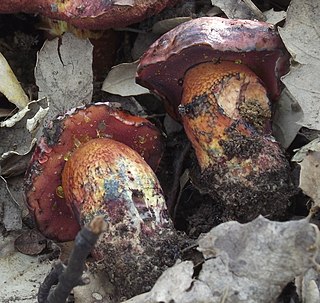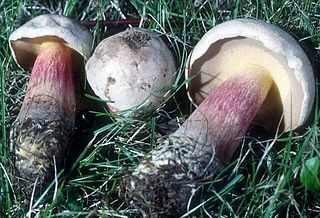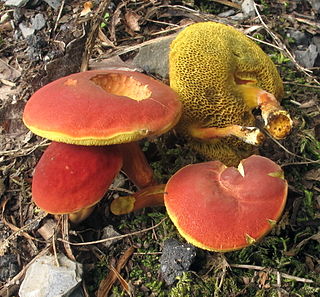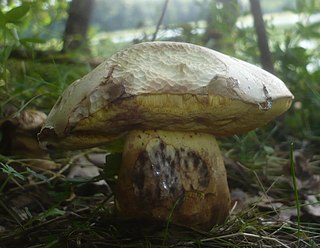
Rubroboletus rhodoxanthus is a species of bolete in the family Boletaceae, native to Europe. Previously known as Boletus rhodoxanthus, it was transferred in 2014 to the newly erected genus Rubroboletus, based on DNA data.

Exsudoporus permagnificus is a species of bolete fungus in the family Boletaceae, native to Southern Europe and Western Asia. Described as new to science in 1981, the fungus was originally placed in genus Boletus. Following molecular studies outlining a new phylogenetic framework for Boletaceae, the fungus was transferred to the newly erected genus Exsudoporus in 2014, to which it is the type species. Nevertheless, Wu and colleagues (2016) were reluctant to accept the newly proposed genus due to a lack of sufficient sequences and regarded it a synonym of Butyriboletus. Following studies reinstated the status of Exsudoporus as a monophyletic genus sister to Butyriboletus, following additional collections and extended phylogenetic and morphological analyses.

Caloboletus inedulis is a bolete fungus of the family Boletaceae that is native to North America. Until 2014, it was known as Boletus inedulis. Recent changes in the phylogenetic framework of the Boletaceae prompted the transfer of this species, along with several other related boletes, including Caloboletus calopus, to the genus Caloboletus. The species is inedible.

Caloboletus firmus is a bolete fungus native to North America. Until 2014, it was known as Boletus firmus. Recent changes in the phylogenetic framework of the family Boletaceae prompted the transfer of this species, along with several other related boletes, including Caloboletus calopus, to the genus Caloboletus. It was first described scientifically in 1874 by American botanist Charles Christopher Frost from specimens collected in New England.

Lanmaoa carminipes is a fungus of the family Boletaceae native to the United States. First described officially in 1971 by mycologists Alexander H. Smith and Harry Delbert Thiers as a species of Boletus, it was transferred to the newly circumscribed genus Lanmaoa in 2015.
Butyriboletus peckii is a fungus of the genus Butyriboletus native to eastern North America. It was first described by Charles Christopher Frost in 1878. Until 2014, it was known as Boletus peckii. Recent changes in the phylogenetic framework of the Boletaceae prompted the transfer of this species, along with several other related boletes, including Caloboletus calopus, to the genus Caloboletus. In 2015, Kuan Zhao and colleagues published analysis that demonstrated that the bolete belongs to Butyriboletus, closely related to Butyriboletus pulchriceps.

Lanmaoa is a fungal genus in the family Boletaceae. It was circumscribed by Chinese mycologists Nian-Kai Zeng and Zhu L. Yang in 2015 to contain several species formerly classified in the genus Boletus, as well as the newly described Asian boletes L. angustispora and L. asiatica. The erection of this genus follows recent molecular studies that outlined a new phylogenetic framework for the family Boletaceae. Zeng and Yang named the genus after Chinese naturalist Lan Mao (1397-1476).

Baorangia is a fungal genus in the family Boletaceae. It was circumscribed by Chinese mycologists Gang Wu and Zhu L. Yang in 2015 with B. pseudocalopus as the type species. Baorangia emilei and B. bicolor were transferred to the genus from Boletus that same year. The erection of Baorangia follows recent molecular studies that outlined a new phylogenetic framework for the Boletaceae. The generic name—derived from the Chinese words bao ("thin") and rang ("hymenium")—refers to the characteristically thin hymenophore, which distinguishes it from all other Boletaceae genera.

Parvixerocomus is a fungal genus in the family Boletaceae. It was circumscribed by Chinese mycologists Gang Wu and Zhu L. Yang in 2015 with Parvixerocomus pseudoaokii from Guangdong province in southern China as the type species. Parvixerocomus aokii of southern China, including Hainan province, and Japan, was also transferred to the genus from Boletus that same year. The erection of Parvixerocomus follows recent molecular studies that outlined a new phylogenetic framework for the Boletaceae. The generic name—derived from the Latin stem parvi- ("small") and Xerocomus as the mushrooms resemble small versions of those from the genus Xerocomus.

Neoboletus is a genus of fungi in the family Boletaceae, native to holarctic regions. It was circumscribed in 2014 by Italian mycologists Matteo Gelardi, Giampaolo Simonini and Alfredo Vizzini, and further by Chinese mycologists Gang Wu and Zhu L. Yang in 2015. Closely related to the genus Sutorius, members of this genus differ by staining blue when bruised. They have brown pores and lack a reticulated pattern on their stipes. The erection of Neoboletus follows recent molecular studies that outlined a new phylogenetic framework for the Boletaceae. The type species is Neoboletus luridiformis. Five species were added to the genus by Gelardi and Vizzini in 2014.

Parvixerocomus aokii is a species of bolete fungus in the family Boletaceae. It was originally described by Japanese mycologist Tsuguo Hongo in 1984 as a species of Boletus. Chinese mycologists Gang Wu, Nian-Kai Zeng, and Zhu L. Yang transferred it to Parvixerocomus in 2015. It is known only from China and Japan, where it grows in tropical and subtropical forests with trees of the family Fagaceae.
Parvixerocomus pseudoaokii is a species of bolete fungus in the family Boletaceae, and the type species of the genus Parvixerocomus. It was described by Chinese mycologists Gang Wu and Zhu L. Yang in 2015. It is found only in southwestern, southeastern and southern China, where it grows in subtropical forests with trees of the family Fagaceae, and in mixed forests with Fagaceae and Chinese red pine. Fruitbodies of the fungus are small, with convex to flattened caps typically measuring 0.8–3 cm (0.3–1.2 in) in diameter. All parts of the bolete stain blue when cut or injured.

Caloboletus is a fungal genus in the family Boletaceae. It was circumscribed by Italian mycologist Alfredo Vizzini with Caloboletus calopus as the type species. The erection of Caloboletus follows recent molecular studies that outlined a new phylogenetic framework for the Boletaceae. Boletus peckii was also transferred to this genus by Vizzini, but was subsequently moved to the genus Butyriboletus based on molecular evidence. The generic name Caloboletus, derived from the Greek calos "nice", refers to the attractive red coloring of the stipe.

Imperator is a genus of fungi in the family Boletaceae. It was circumscribed in 2015 by Boris Assyov and colleagues. The erection of Imperator follows recent molecular studies that outlined a new phylogenetic framework for the Boletaceae.

Caloboletus frustosus is a bolete fungus native to North America. Until 2014, it was known as Boletus frustosus. Recent changes in the phylogenetic framework of the family Boletaceae prompted the transfer of this species, along with several other related boletes, including Caloboletus calopus, to the genus Caloboletus. It was first described scientifically in 1941 by mycologists Wally Snell and Esther Dick.

Hortiboletus is a genus of fungi in the family Boletaceae. It was circumscribed in 2015 by Giampaolo Simonini, Alfredo Vizzini, and Matteo Gelardi. The erection of Hortiboletus follows recent molecular studies that outlined a new phylogenetic framework for the Boletaceae. Hortiboletus is derived from the Latin word hortus "garden", referring to a typical habitat of the type species, Hortiboletus rubellus. The bolete H. bubalinus, originally described as a Boletus and later placed in Xerocomus, was transferred to the genus by Bálint Dima. In 2015, Alona Yu. Biketova transferred Boletus campestris and Boletus engelii to Hortiboletus.
Caloboletus panniformis is a bolete fungus native to Honshu island in Japan, where it grows under conifers in subalpine regions. Until 2014, it was known as Boletus panniformis. Recent changes in the phylogenetic framework of the family Boletaceae prompted the transfer of this species, along with several other related boletes, including Caloboletus calopus, to the genus Caloboletus. It was first described scientifically in 2013 by Japanese botanist Haruki Takahashi and colleagues.

Boletus violaceofuscus is a fungus of the genus Boletus native to China. First Described by W.F Chiu in 1948. It is related to Boletus separans.

Caloboletus kluzakii is a bolete fungus native to Europe. Until 2014, it was known as Boletus kluzakii. Recent changes in the phylogenetic framework of the family Boletaceae prompted the transfer of this species, along with several other related boletes, including Caloboletus calopus, to the genus Caloboletus. It was described scientifically in 2006 by Josef Šutara and Pavel Špinar, from specimens collected in the Czech Republic. The fungus had earlier been published with the name Boletus fallax by Czech mycologist Zdeněk Kluzák in 1988, but this was invalid, as that name had been used previously by E.J.H. Corner for a Malaysian bolete. The epithet honours Kluzák's contributions in describing the species.

Exsudoporus is a genus of fungi in the family Boletaceae. It was circumscribed in 2014 by Alfredo Vizzini and colleagues, following a number of molecular studies that outlined a new phylogenetic framework for Boletaceae and revealed the genus Boletus in its traditional circumscription to be polyphyletic. However, due to lack of sufficient sequences, Wu and colleagues (2016) were reluctant to accept the newly proposed genus and considered it a synonym of Butyriboletus. Following additional phylogenetic sequencing and morphological analyses, Exsudoporus was clearly resolved as a monophyletic, homogenous and independent genus that is sister to Butyriboletus.















